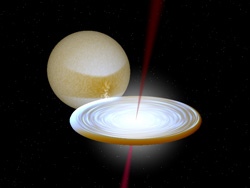Spitzer Telescope reveals jets of matter around dead star

A computer-generated visualisation of a black hole or neutron star X-ray binary system. Image produced using a visualisation tool provided by Rob Hynes of the Louisiana State University, USA.
Previously, these steady ‘relativistic jets’ were only seen from black holes which form part of a black hole X-ray binary, a system containing a black hole orbited by a normal star which is so close that the black hole's gravity can peel off the outer part of the normal star and suck in its gas through an accretion disk or disk of matter.
Using the extremely sensitive infrared Spitzer Space Telescope recently launched by NASA, the team discovered one of these steady jets of matter coming from a neutron star (a super-dense type of dead star) in an X-ray binary system. For many years scientists have debated whether there was something unique to black holes that fuelled relativistic jets. It is now clear that the jets must be fuelled by something that both black holes and neutron stars share.
Neutron stars form in the death knells of massive stars, when the pressure at the centre of the star is so large that the electrons and protons of normal matter combine to form a star made almost entirely of neutrons. Not quite dense enough to be black holes, they have masses slightly larger than the Sun's, but diameters about the size of a city, making them as dense as the nuclei of atoms.
Dr Thomas Maccarone, of the University of Southampton, explains: ‘Jets of matter shot off by black holes are usually observed with a radio telescope which enables astronomers to isolate the jet from everything else in the system. However, observing a neutron star’s jets with a radio telescope would take many hours because the jets are very faint. The Spitzer Space Telescope sees light which is redder than the reddest colours visible by the human eye and also redder than the light given off by normal stars.’
Using the Spitzer Telescope, the researchers were therefore able to detect the faint jet of a particular neutron star, 4U 0614+091, in minutes even though it is located about 10,000 light-years away in the constellation Orion. This signal would have taken almost a day to detect on the most powerful radio telescopes on Earth. The Spitzer Telescope also helped the team infer details about the jet’s geometry. The team’s data indicates that the presence of an accretion disk and an intense gravitational field may be all that is needed to create and fuel a jet of matter.
Dr Maccarone continues: ‘For the past 25 years, astronomers have debated the importance of a black hole in jet production. By comparing the behaviour of the relativistic jets seen from neutron star X-ray binaries and from black hole X-ray binaries, astronomers have hoped to compare neutron stars and black holes directly and possibly to see whether these jets are extracting the black holes' rotational energy. This discovery blazes the trail for future studies which should help reveal the nature of relativistic jets.’
Media Contact
More Information:
http://www.soton.ac.ukAll latest news from the category: Physics and Astronomy
This area deals with the fundamental laws and building blocks of nature and how they interact, the properties and the behavior of matter, and research into space and time and their structures.
innovations-report provides in-depth reports and articles on subjects such as astrophysics, laser technologies, nuclear, quantum, particle and solid-state physics, nanotechnologies, planetary research and findings (Mars, Venus) and developments related to the Hubble Telescope.
Newest articles

Recovering phosphorus from sewage sludge ash
Chemical and heat treatment of sewage sludge can recover phosphorus in a process that could help address the problem of diminishing supplies of phosphorus ores. Valuable supplies of phosphorus could…

Efficient, sustainable and cost-effective hybrid energy storage system for modern power grids
EU project HyFlow: Over three years of research, the consortium of the EU project HyFlow has successfully developed a highly efficient, sustainable, and cost-effective hybrid energy storage system (HESS) that…

After 25 years, researchers uncover genetic cause of rare neurological disease
Some families call it a trial of faith. Others just call it a curse. The progressive neurological disease known as spinocerebellar ataxia 4 (SCA4) is a rare condition, but its…





















